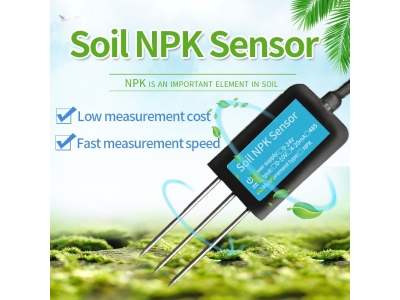Agriculture has come a long way over the years, with the advent of technology revolutionizing the way crops are grown and harvested. With the world’s population increasing at an unprecedented rate, there is a growing need to produce more food with limited resources. Precision agriculture is one such technology that has emerged as a game-changer in agriculture, enabling farmers to optimize crop yields while minimizing inputs such as water, fertilizer, and pesticides. Soil sensors are an essential component of precision agriculture and play a crucial role in providing accurate and real-time data about soil conditions. This article explores the growing importance of soil sensors in precision agriculture and their potential to revolutionize farming practices.

Understanding Soil Sensors
Soil sensors are electronic devices that measure various parameters related to soil conditions. These parameters include soil moisture, temperature, salinity, pH, and nutrient levels. Soil sensors work by detecting changes in electrical conductivity, resistance, or other properties of the soil, which are then translated into measurable data.
Soil sensors are used extensively in precision agriculture to provide farmers with real-time data about soil conditions. This data helps farmers make informed decisions about crop management practices such as irrigation, fertilization, and pest control. By providing accurate information about soil conditions, soil sensors enable farmers to optimize crop yields while minimizing inputs, leading to increased productivity and profitability.
Advancements in Soil Sensor Technology
Over the years, soil sensor technology has seen significant advancements, leading to improved accuracy, reliability, and ease of use. Some notable advancements include:
Wireless Connectivity:
Soil sensors are now equipped with wireless communication capabilities, enabling real-time data transmission to central monitoring systems. This allows farmers to access soil data from anywhere, anytime, and make informed decisions on-the-go.
Low-power Consumption:
Energy-efficient soil sensors have been developed, enabling long-term and continuous monitoring without excessive power requirements. This is especially important for remote or battery-operated monitoring systems.
Miniaturization:
Soil sensors have become increasingly compact and portable, allowing for easy integration into various farming practices. This miniaturization has opened up new possibilities for precision agriculture in both indoor and outdoor environments.
Multi-Parameter Sensing:
Soil sensors can now measure multiple parameters simultaneously, enabling comprehensive soil data collection. This reduces the need for multiple sensors and simplifies data analysis.
Applications of Soil Sensors in Precision Agriculture
Soil sensors have a wide range of applications in precision agriculture, with some key areas of use including:
Irrigation Management: Soil sensors are used to monitor soil moisture levels, allowing farmers to optimize irrigation practices. This reduces water waste and ensures that crops receive the optimal amount of water, leading to increased yields and reduced costs.
Fertilizer Management:
Soil sensors are used to monitor nutrient levels in the soil, enabling farmers to apply fertilizers more precisely. This reduces fertilizer waste and ensures that crops receive the optimal amount of nutrients, leading to increased yields and reduced costs.
Pest Control:
Soil sensors are used to monitor soil conditions, which can affect pest populations. By monitoring soil conditions, farmers can identify potential pest problems and take proactive measures to control them, reducing the need for pesticides.
Plant Health Monitoring:
Soil sensors are used to monitor soil conditions, which can affect plant health. By monitoring soil conditions, farmers can identify potential plant health problems and take proactive measures to prevent them, leading to healthier crops and increased yields.
Future Perspectives
The future of soil sensor technology in precision agriculture looks promising. As the demand for real-time and accurate soil data collection continues to rise, further advancements can be expected. Some potential areas of development include:
Artificial Intelligence (AI) and Machine Learning:
AI and machine learning algorithms can be applied to soil sensor data to provide more accurate and real-time analysis. This will enable farmers to optimize crop management practices further and make informed decisions based on data-driven insights.
Integration with Smart Systems:
Soil sensors can be integrated with smart systems and the Internet of Things (IoT) for enhanced data collection, analysis, and visualization. This integration will enable real-time monitoring, data sharing, and informed decision-making.
Affordable and Accessible Sensors:
Efforts are being made to develop low-cost soil sensors without compromising accuracy and reliability. Affordable sensors would promote wider adoption, allowing for broader soil data collection coverage, especially in resource-limited areas.
Sensor Fusion:
Soil sensors can be combined with other sensing technologies such as remote sensing and aerial photography to provide a more comprehensive view of crop conditions. This will enable farmers to make more informed decisions and optimize crop management practices further.
Conclusion

Soil sensors are an essential component of precision agriculture and have the potential to revolutionize farming practices. Advancements in soil sensor technology have significantly improved their accuracy, sensitivity, and reliability, enabling better measurement and analysis of soil conditions. With further advancements and integration with smart systems, soil sensors will contribute to more effective crop management practices, increased productivity, and profitability. It is crucial to continue investing in research and development to harness the full potential of soil sensors and address the global food security challenge.
